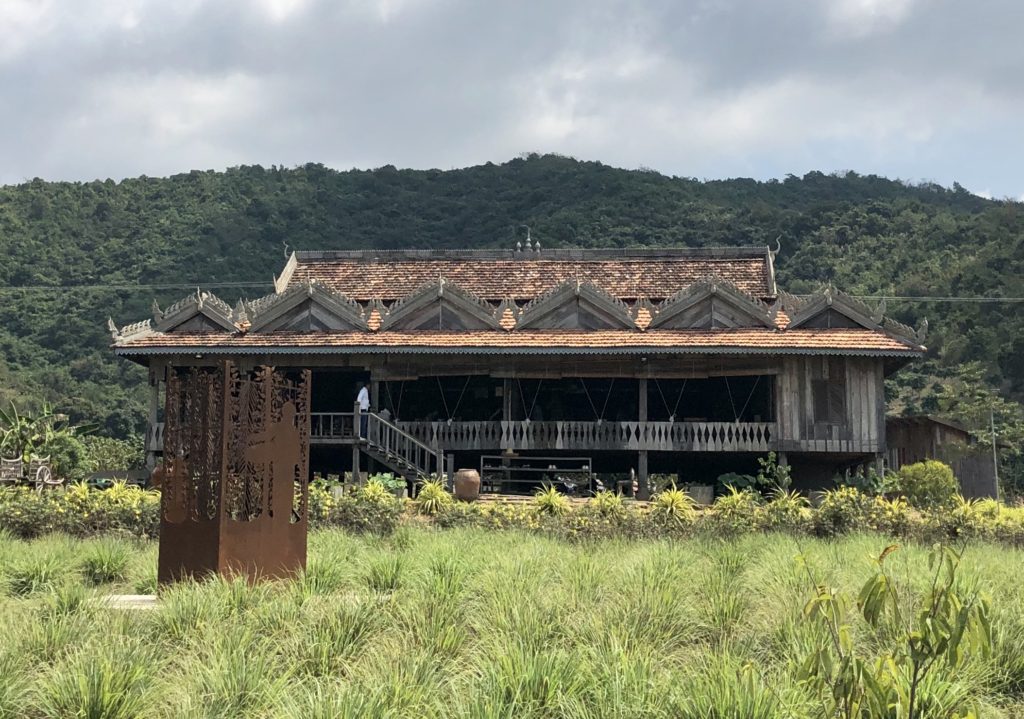Kampot was lovely, a nice break from the dusty honking frenzy of Phnom Penh. It was a chance to explore a bit of the Cambodian countryside, with Brahma cattle, monks, shrines, hammocks, and rice paddies. Tuk-tuks and motorcycles transport just about everything! One motorcyclist had about ten dead chickens on each side, feathers on, feet tied together. Another motorcycle transported a giant block of ice. A man walking a bicycle to which at least two dozen coconuts had been attached. Tuk-tuks transporting construction materials, durian fruit, bananas, fancy dresses, mattresses, you name it!
Buddhist monks in their orange robes cheerfully roaming the dusty orange streets. Most homes have little shrines at their entrance, and then
The Kampot region is famous for its Kampot peppers and its stinky durian fruit; there is even a statue at a traffic roundabout honoring the durian!
We did some rock climbing with
Greenhouse is located a few kilometers outside of town. Owned by a Frenchman named Stefan, its touches are comically French and most excellent. Ashtrays everywhere, a bidet spray in every bungalow, a long list of excellent wines, very nice French cheeses and excellent French fare in the middle of the Cambodian countryside! The main restaurant/bar was originally a bar called Maxine’s in Phnom Penh; it was slated to be demolished in the name of development, and the Greenhouse people disassembled it, moved it to Kampot, and reassembled it. I complimented Stefan on this achievement; he told me, “you can do anything if you are French!”
Greenhouse accepts cash and Bitcoin, but not credit credit cards…
It was interesting to talk to Bjorn, our guide on the Kampot river tour
He talked a lot about various political problems in Cambodia. How the Chinese are taking everything over. How they bought out Sihanoukville to turn it into another Macau, and how it changed in a very short time for my fishing village to play some skyscrapers. When he visited recently, he thought he had taken a wrong turn someplace because he totally didn’t recognize the place, with all of its cleaning new buildings built by Chinese workers laboring around the clock.
The US dollar has been a second currency here in Cambodia, but it seems that it will soon be replaced by the Chinese yen. The Chinese are investing a great deal of money in Cambodia, Laos
Bjorn talked about how
Bjorn talked about how pockets of Khmer Rouge survived in Cambodia until
Stefan, the owner of the Greenhouse, ask me about my boat ride with Bjorn. I told him how lovely it was, with the fruit trees in the sunset and the birdwatching, and that it had been interesting to talk about politics.
“He talked to you about politics? I would never do that!”
“ Cambodia has given me everything, it is given me a family, just given me a business, it is good he respects. But I would never start to talk about politics with anyone. Mostly for the safety of the 22 people who work here”
Declan and I both spent a morning at a place called
“Oh, I just rent. I used to think that I would like a lease, but now I know that the lease is meaningless. I have many friends who think that they are protected because of their lease, and then along comes someone else with more money and they are out.” David told me.
Declan liked
It’s interesting to see the relationship between economic development, community development, and preservation. At La Plantation, they are clearly working on community development. There was also an old pagoda that they moved from the town to the plantation to serve as its main building. It is a very lovely building. I hope that they moved it in order to preserve it, rather than thank that they robbed the town of their pagoda.
As we watched the sunset on the Kampot river with Bjorn, a sliver of a moon appeared. Unlike in the US, where I always see the crescent moon as “C”, this moon looked liked a “U” or a smiley face. “I knew that Cambodia was the place for me, ” said Bjorn. “Even the moon was smiling at me!”
On to Mondulkiri and the Elephant Valley Project!












Wonderful adventure! The Greenhouse sounded fabulous. I was wondering how this country was healing from their political past. It will take time & generations to come.
Comments are closed.